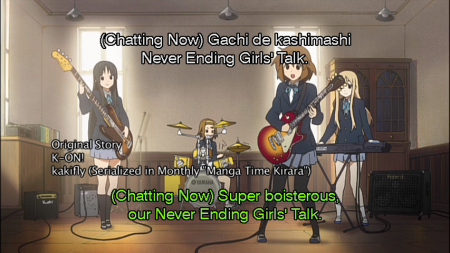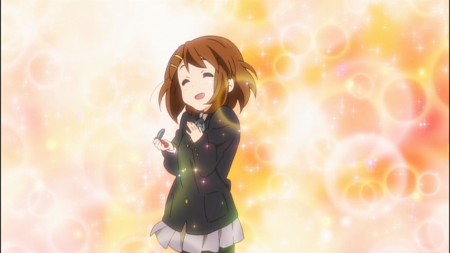K-On! DVD 1 Review
After animating the smash hit Melancholy of Haruhi Suzumiya television series in 2006 then following it with the equally successful Lucky Star television series the following year, the rapidly ascending Kyoto Animation production studio did what came naturally: a third consecutive anime series revolving around the daily lives of cute high school girls. The 2009 K-On! television series became a massive sensation in Japan, creating a legion of devoted fans, setting sales records, and even contributing to invigorated sales of affiliated products like guitars and high-fidelity headphones. After an excruciating two year wait, the beloved K-On! anime series is finally coming to America, courtesy of Bandai Entertainment. For eager fans, the wait will be rewarded. For the uninitiated, the event will allow an opportunity to see, and hear, what the fuss is all about.
The anime adaptation of Kakifly’s manga illustrates the high school lives of Yui, Ritsu, Mio, and Mugi, the freshman girls and aspiring musicians that make up their high school’s light music (pop music) club. The anime series follows the initial formation of the club, the induction of a new member, the formation of the girls’ band and their first live performance, and, eventually in the show’s second season, the girls’ high school graduation. Although ostensibly about a fresh faced girls’ rock band, much of the narrative revolves around slice-of-life situational humor, and the girls spending their time chatting and eating snacks instead of practicing their performances. So the degree to which individual viewers will appreciate the show depends heavily upon the expectations brought to the show. K-On! is a lighthearted comedy that excels at characterization and subtle charm. Viewers willing to let the show work its magic will find themselves irresistably pulled into the show’s whimsical pace, starting from the very first episode.
Each of the four starring girls has a unique and complimentary personality. Protagonist Yui is ditzy, easily distracted, and naturally optomistic. Ritsu is a slightly egomaniacal tomboy, an aggressive, outgoing girl that leads those around her by pure momentum. Her best friend, Mio, is reserved and responsible, serving as a perfect foil to Ritsu. Mugi is a wide-eyed ingenue who serves as a sort of ego mediating between Ritsu’s id and Mio’s superego. The show gives each girl plenty of screen time and development, frequently using subtle illustration and contrast to reveal and reinforce each girl’s personality. Contrasting scene pacing at the beginning of the first episode characterizes Yui without ever saying a word. Juxtaposing Ritsu, Mio, and Mugi’s feet solidly on the ground with Yui’s dancing feet at the end of the first episode further silently suggests Yui’s flighty and capricious nature. The animation also exhibits subtle character through the exploitation of subtle satire. Scenes like Ritsu begging Mio to join the light music club and literal illustration of Yui’s clumsiness lovingly evoke anime conventions that give the show itself character and personality. Wildly varied background music also subtely contributes to the show’s tone, effectively suggesting character and influencing the viewer’s perception of characters and situations. Viewers that demand overt action and clearly deliniated conflict may find K-On! pointless and dull, but viewers that approach the show receptively will find it immediately engaging, playful, and affecting.
The first domestic DVD includes the series’s opening four episodes, a ten-minute interview with voice actress Stephanie Sheh, the English voice of Yui, and trailers for Bandai’s forthcoming releases of The Girl Who Leapt Through Space, Tales of the Abyss, and The Disappearance of Haruhi Suzumiya. The DVD menu is static and silent, which allows for fast loading and easy navigation but also seems a bit lifeless in relation to such a playful show. The episodes are presented in anamorphic widescreen, either with English spoken dialogue and slates, or Japanese dialogue with subtitles and slates. The subtitles include karaoke lyrics for the original Japanese opening and ending theme songs, kept intact on both the English and Japanese audio tracks. Purists will find that the honorific “-chan” is romanized in the subtitles while “-san” is translated as “Miss.” The Japanese terms “NEET” and “sensei” appear in the subtitles once each without any translation or definition. Observant subtitle viewers will appreciate that Mugi’s formal speech is conveyed through slightly more formal phrasing in her subtitled dialogue. On-screen Japanese text throughout, including the opening credits, title logo, and episode titles, are left in Japanese and captioned. On a standard definition television, the DVD color was warm and crisp with no sign of compression artifacting or ghosting. The Dolby stereo Japanese audio sounds fine, however, the English audio mix may be just a little off, as the English language dialogue track often seems to be just a bit drowned by the original sound effects and BGM. I encountered playback glitches at 10:22 into the first episode and in the next episode preview following episode two, but since I wasn’t able to replicate the glitches, my DVD player, rather than the DVD, may have been to blame. I’m not a proponent of dubbing, thus I’m not an objective critic of English dubs. I’ll give credit to Bang Zoom Entertainment for selecting English language voices that distinctly replicate the timbre and tone of the original Japanese performances, but Sheh’s leading performance as Yui seemed weakest to me, sounding timid and whispered rather than capricious.
K-On! is a long awaited American premiere with a large fan following and a new American audience that remains to be seen. The show won’t appeal to everyone. Viewers with a preference for action and adventure will be immediately disengaged by the leisurely development of K-On! But viewers who appreciate the engaging and immersive power of substantial characterization and natural, believable character relationships will find K-On! charming, endearing, and fun. Bandai’s DVD release does a fine job of presenting the original show in a solo spotlight, allowing it to win over viewers with its own attributes. To quote the Sakurakou K-On Bu, “Please don’t say ‘You are lazy’.” Consider picking up the K-On! volume one DVD or Blu-ray.
Add a Comment
You must be logged in to post a comment.








In short it’s just an anime full with moeblobs with music ridiculously praise by KyoAni fans.
Lame.
When I first saw this, my response was that you did it again. There will be a big to-do at Sakura-Con in a few days to premiere the K-On! anime. I hope this time it turns out better than when you gave a rather scathing review of GunXSword a few years ago just days before a similar big to-do for the anime’s premiere at Sakura-Con. The result unfortuantely was a disaster for the anime’s premiere because everyone went it saying it was terrible. So, I can only hope for the best this time around, as this review was much more positive.
“Viewers that demand [pointfulness and expression in their anime] may find K-On! pointless and dull”
That’s for sure. I’m not averse to moe, idyllic anime or Kyoto Animation, but the whole time I was wishing for the show to ever so slowly develop into a subversive and harrowing exposé on the music & idol industry, traumatizing its unsuspecting viewers like frogs in gradually boiling water. Or it could’ve been a little more about music at the least, its supposed subject matter. I jumped ship after 6 monotonous episodes of cake, spring breaks, and other ground well-traveled by decades of previous anime.
It didn’t present an imaginative world like other idyllic anime I’ve seen (YKK, Aria, Kamichu), and obviously it lacked the conflict, drama and parody of other moe-centric Kyoto Animation work (Haruhi, Kanon, Clannad), so I don’t understand how K-On is supposed to best its peers. Yet it’s a sensation with 41 episodes, a fourthcoming movie, and a never-ending torrent of merchandise. I dunno lol.
I pride myself on watching and enjoying anime of all types, genre, and levels of story depth. Yet, not a single anime Kyoto Animation has produced so far has been any good in my opinion. Haruhi had a single character that was interesting and one really good scene. Lucky Star was like eating an entire chocolate cake for breakfast, and K-on…well honestly I was done after Lucky Star.
I don’t think I will give this a second thought.
I think the show has a lot of merit, especially since the music in the shows is diverse and displays both cuteness with a subtle hint of wildness. It’s a blend that I find intriguing, and the addition of lots of tunes helps make it even more fun to watch.
I agree that Stephanie Sheh is definitely the wrong person to be dubbing for Yui. Most likely the director wanted her to get up into typical moe pitch range with the voice, but all too often, she sounds strained and weak. The typical nasal tone with a touch of fine sandpaper is almost completely gone, only making a rare appearance like an afterthought.
About most of the others who left comments: if they dislike cute shows so much, why did they bother with this one at all?
I don’t think they hate cute shows they just want their cute shows to have some form of substance. Seanny mentioned anime like Aria for example and wished that K-On! was deeper and more meaningful. I believe it has nothing to do with the cute girls but the structure they are put in that turns people off. I personally have no problem with shows like this in fact I love K-On! and a lot of other “moeblob” shows that people have a problem with here.